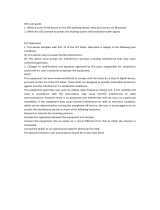Windows®, Windows XP®, Windows Vista®, Windows 7®, Windows 8®, Windows 10® are trademarks of the
Microsoft group of companies. Mac® and Mac OS® are trademarks of Apple Inc., registered in the U.S. and
other countries. TOSlink® is a registered trademark of Toshiba corporation. Dolby® is a registered trademarks
of Dolby Laboratories. DTS™ is a registered trademark of DTS, Inc. DSD and the DSD logo are trademarks of
Sony Corporation.
BT® is a trademark owned by the BT SIG, Inc., , Microsoft®, Windows®, are either registered trademarks or
trademarks of Microsoft Corporation, Apple is registered trademark of Apple Inc., Android™ is a trademark of
Google Inc.
Waste from Electrical and Electronic Equipment (WEEE): This directive mandates the collection and recycling
of electronics and component materials in order to reduce the amount going to landfills. Outside North
America, when the user decides to discard this product, it must be sent to a separate collection facility for
recycling. Please contact your point of purchase for more details.
Federal Communication Commission (FCC) Interference Statement FCC Part 15: This equipment has been
tested and found to comply with the limits for a Class B digital device, pursuant to Part 15 of the FCC Rules.
These limits are designed to provide reasonable protection against harmful interference in a residential
installation. This equipment generates, uses and can radiate radio frequency energy and, if not installed and
used in accordance with the instructions, may cause harmful interference to radio communications. However,
there is no guarantee that interference will not occur in a particular installation. If this equipment does cause
harmful interference to radio or television reception, which can be determined by turning the equipment off
and on, the user is encouraged to try to correct the interference by one or more of the following measures:
- Reorient or relocate the receiving antenna
- Increase the separation between the equipment and receiver
- Connect the equipment into an outlet on a circuit different from that to which the receiver is connected
- Consult the dealer or an experienced radio/TV technician for help.
This device complies with part 15 of the FCC Rules. Operation is subject to the following two conditions: (1)
This device may not cause harmful interference, and (2) this device must accept any interference received,
including interference that may cause undesired operation. FCC Radiation Exposure Statement: This equipment
complies with FCC radiation exposure limits set forth for an uncontrolled environment.
To maintain compliance with FCC´s RF exposure guidelines, this equipment should be installed and operated
with minimum distance 20cm between the radiator and your body. Use on the supplied antenna.
Contains FCC ID: 2AWO-FSCBT1026








